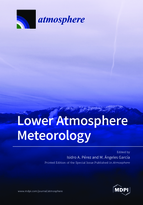Lower Atmosphere Meteorology
A special issue of Atmosphere (ISSN 2073-4433). This special issue belongs to the section "Meteorology".
Deadline for manuscript submissions: closed (31 May 2019) | Viewed by 48836
Special Issue Editors
Interests: air pollution meteorology; micrometeorology; statistics of meteorological observations; climate change
Special Issues, Collections and Topics in MDPI journals
Interests: air parcel trajectories; air pollution meteorology; climate change; greenhouse gases
Special Issues, Collections and Topics in MDPI journals
Special Issue Information
Dear Colleagues,
Interaction between the biosphere and the atmosphere is made through its lowest layer; hence, this Special Issue is devoted to the meteorological processes in this region. Although theoretical developments, such as model calculations, are not excluded, experimental and interdisciplinary studies are specially welcomed. Analyses of precipitation, wind speed, and solar radiation distribution may have a relevant academic interest due to their marked impact on population and energy production. Moreover, issues such as air pollutant dispersion, turbulent fluxes, or the evolution of radioactive isotopes and dangerous gases are conditioned by lower atmosphere meteorology. Other subjects falling in the scope of this Special Issue are the relationship among meteorological variables and the exchange between the atmosphere and its boundary layer. Consequently, this Special Issue is suggested to highlight the influence that the meteorological processes occurring in the layer close to the surface have on living beings and materials. The expected result will be a global vision of the impact of meteorology on life to increase insights in this field, to take the best decisions in human activities and to reduce the adverse effects of natural processes.
Dr. Isidro A. Pérez
Dr. M. Ángeles García
Guest Editors
Manuscript Submission Information
Manuscripts should be submitted online at www.mdpi.com by registering and logging in to this website. Once you are registered, click here to go to the submission form. Manuscripts can be submitted until the deadline. All submissions that pass pre-check are peer-reviewed. Accepted papers will be published continuously in the journal (as soon as accepted) and will be listed together on the special issue website. Research articles, review articles as well as short communications are invited. For planned papers, a title and short abstract (about 100 words) can be sent to the Editorial Office for announcement on this website.
Submitted manuscripts should not have been published previously, nor be under consideration for publication elsewhere (except conference proceedings papers). All manuscripts are thoroughly refereed through a single-blind peer-review process. A guide for authors and other relevant information for submission of manuscripts is available on the Instructions for Authors page. Atmosphere is an international peer-reviewed open access monthly journal published by MDPI.
Please visit the Instructions for Authors page before submitting a manuscript. The Article Processing Charge (APC) for publication in this open access journal is 2400 CHF (Swiss Francs). Submitted papers should be well formatted and use good English. Authors may use MDPI's English editing service prior to publication or during author revisions.
Keywords
- micro–meso scale meteorology
- model development and application
- atmospheric boundary layer
- air parcel trajectories







